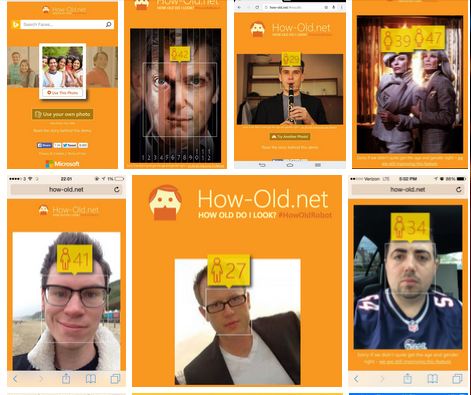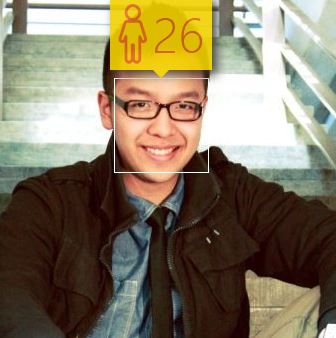Earlier this week, while browsing through my social media feeds, I saw something that quickly caught my eye.
Does this look familiar?

As some of you may know, the site How-Old.net stormed many of our Facebook, Twitter, and Instagram feeds starting from last Friday. For those of you who may not know yet, How-Old.net is an online app from Microsoft where users can upload a picture of themselves and the app’s algorithm analyzes your face and – based on your photo – suggests your estimated age; which could be to your delight or to your disappointment (directing that comment to all my aunts on Facebook). This app really took off (even to the surprise of its own creators) and, over the last week, it seemed like almost all of my friends and family were sharing their own versions all over social media.
So why am I writing this blog post?
Looking at these pictures being shared from friends all the way to business leaders, it made me think about the prevalence of other similar movements over the past several years. Anyone remember the ALS Ice Bucket Challenge? How about Harlem Shake? Gangnam Style? Who can forget Kony 2012? Or even just your friend sharing the latest Batman v Superman leak? This really made me wonder…
Why do we share things online?
What motivates us to participate and share in these online movements? What makes us so excited to upload our own photo or our own version and show it off to our friends?
Curious me decided to look into it, and I’d like to share with you three things I discovered…
Three Reasons We Share Content Online
According to a study conducted by the New York Times Customer Insight Group on “The Psychology of Sharing“: sharing is all about relationships. We share to receive or provide some sort of benefit to our network of relationships online. Here are some of the ways that can take shape:
1. Grow and Nourish Relationships
Many times, people share things like the latest movie trailer leak or burrito cat to bring valuable and entertaining content to their friends and family. For the most part, according to the New York Times study, the reason why 78% of us do this is because it allows us to stay connected to people that we might not otherwise keep in touch with. As a random example, if we think about the last time we tried to get back in touch with one of our Facebook friends, which of the two scenarios seems more likely:
- A post on their timeline saying, “Hey, how’s it going?”
- A link on their timeline to a video saying, “Omg saw this and totally reminded me of you…”
Again, this might not be the case everywhere; but the idea is that a lot of the times, when we share content with others online, we use it merely as an instrument to help express sentiments of care, friendship, and even love, simply by providing utility or entertainment.
2. Define Ourselves to Others
One of the more interesting things I discovered about why we share content ultimately has to do with who we are. Or rather, who we want to be. Sharing things online, according to New York Times, allows people to give others a better sense of who they are, what they care about, and who they want to be. Whether we’re sharing Business Insider articles, Buzzfeed videos, Chipotle’s guac recipe (yes!), or changing our profile pictures to support the causes we care about, it allows us to craft and reinforce our online image to share to the world. Shimi Cohen’s “Innovation of Loneliness” said it best: I share, therefore I am.
Sometimes, we can even make the argument that sharing online can take on a form of narcissism. Ernest Dichter’s classic 1966 study on “Word of Mouth” reveals that one of the reasons people “talk” about brands is for self-confirmation. These could include people who share because they are “seeking attention”, “showing connoisseurship” (looking smarter), or appearing to have “insider information”.
According to the New York Times study, there are six personas that tend to share content. These personas can be defined by their emotional motivations, desired presentation of their self and how valuable it is to them that they are the first to share something.
- The Altruist: These sharers are helpful, reliable, thoughtful, connected, and use email to share.
- The Careerist: These sharers are intelligent business networkers and are more likely to share content on LinkedIn.
- The Hipster: Less likely than other sharers to use email for sharing content, these sharers are creative, young and popular. They consume content that is on the cutting edge and care about defining their identity.
- The Boomerang: These sharers share information to get a reaction and to feel validated. They are empowered by social media and tend to use both Twitter and Facebook.
- The Connector: Creative, relaxed, thoughtful, making plans, uses both email and Facebook to share information.
- The Selective: These sharers are resourceful, careful, and thoughtful. They share content that is informative and also use email to share content with individuals.
Can you identify with any of these?
3. Our High-Arousal Emotions are Triggered
The last finding that I discovered was from a research paper by Jonah Berger and Katy Milkman called, “What Makes Online Content Viral?” In that study, one of the key highlights was that content that evokes high-arousal emotions tend to be more viral than those without such emotion.
High-arousal emotions can be positive or negative and could include anything from awe, anger (i.e. challenging someone’s beliefs), anxiety (i.e. losing out on something), fear, joy (i.e. funny, inspiring, uplifting), lust, or surprise. Think about the last time you shared a post from Upworthy with a title along the lines of: “Watch a Teenager Bring His Class to Tears Just by Saying a Few Words”. What’s interesting is that we’re more likely to share positive content – even tear-jerkers – than negative ones, according to Berger.
Lessons Learned for Marketers
As a 4th year marketing student, I believe there are some key lessons here for content marketers and especially for myself as a new grad going into this field. We already know that online conversations about your brand and your business are crucial to building the social capital that you need to succeed. In essence, brands and businesses succeed when people within them “trust each other, look out for one another, and work well together… that trust comes from interaction, collaboration and, most of all, conversation.”
So here’s what I personally learned about ways to succeed in content marketing:
- Allow users to connect with each other, not just your brand. Whether it’s through nominations or encouraging competition (i.e. people adding their own epic variation to the Harlem Shake in an effort to top the last person), what makes content (or even memes) go viral is being able to add your own personality to it and then use it as a way to interact with others.
- Appeal to narcissism. Ensure that your content allows users to project their self-image to others, whether it’s their desired youthful age (i.e. #HowOldRobot) or a cause that they care about (i.e. ALS). Make them appear smarter to their network and look like they know something that others don’t. And honestly, everyone loves an excuse to post a photo or video of themselves.
- Trigger positive, high-arousal emotions.
Tear-jerkers FTW.Just make people smile. - Keep your content simple and easy to understand. One of the reasons why #HowOldRobot took off is that it was extremely easy to use and required less than 2-3 clicks to work. Or even taking after Buzzfeed’s famous “listicles” model, using lists to communicate more detailed content allows users to quickly digest and consume information that is spatially organized and presents your required time investment upfront.
- Make sharing easy. If we want content to be shared, then the experience should be as seamless as possible. Again, looking at #HowOldRobot’s user experience, I shared my photo in two clicks and I was done – no required log-in, no required input fields to fill out.
Wrapping It Up
There’s a lot of things we can say about people: we’re curious, we’re creative, we’re social, we’re terrible at remembering things, we like things visual, we love a good story, we want everything fast and easy.
But at the end of the day, the most important lesson for me is that people are most likely to listen to and trust others who are close to them (i.e. Mom > McDonald’s). So, as marketers, if we want our content to be shared online, we need to make sure that it’s credible, it appeals to others, it’s easy, it’s simple to understand, and – above all – I feel good sharing it. Then you can be sure that I’m clicking that share button.
Oh, and for those who were curious…

I was 19 when I took this picture… Do you think it’s the beard?
Sources:
- http://tripleseo.com/why-do-people-share/
- https://medium.com/@yushunwang/10-reasons-why-howoldrobot-gets-viral-1a0eb5cb0d96
- https://vimeo.com/70534716
- http://coschedule.com/blog/why-people-share/
- http://www.brandautopsy.com/2013/09/ernest-dichter-on-word-of-mouth-marketing.html
- http://nytmarketing.whsites.net/mediakit/pos/
- http://www.cnbc.com/id/102640929
- http://www.forbes.com/sites/quora/2015/05/05/how-does-how-old-net-work/
- http://www.socialsignal.com/methodology-grounded-research
- http://www.forbes.com/sites/kiriblakeley/2011/09/06/why-does-something-go-viral/
- http://www.newyorker.com/tech/elements/the-six-things-that-make-stories-go-viral-will-amaze-and-maybe-infuriate-you
- http://www.newyorker.com/tech/elements/a-list-of-reasons-why-our-brains-love-lists
- http://socialtriggers.com/craft-contagious-content/
- https://marketing.wharton.upenn.edu/profile/311/research
- http://www.theguardian.com/media-network/media-network-blog/2014/aug/27/ice-bucket-challenge-lessons-marketing
Pingback: Sharing: The Art and Science of Social Sharing Social Media Examiner
Pingback: Sharing: The Art and Science of Social Sharing | ProminentSocial
Pingback: Sharing: The Art and Science of Social Sharing - Sawcial.com
I didn’t see a beard. I don’t think it knew what it was taking about. You definitely don’t look 26 in that picture to me.
LikeLike